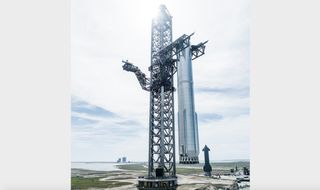
SpaceX's latest Starship Super Heavy booster is back on the launch pad, this time with its full complement of 33 engines.
SpaceX placed the Super Heavy prototype, known as Booster 7, onto its orbital launch mount at Starbase, the company's South Texas facility, on Tuesday (Aug. 23). The heavy lifting was done by "Mechazilla," as SpaceX founder and CEO Elon Musk has dubbed Starbase's 469-foot-tall (143-meter tall) launch tower.
Musk celebrated the milestone on Tuesday via Twitter, posting a photo of Booster 7 grasped in Mechazilla's "chopstick" arms. "Mechazilla loads Starship on launchpad," the billionaire entrepreneur wrote.
Related: SpaceX fires up Starship Super Heavy booster again in long engine test
Mechazilla loads Starship on launchpad pic.twitter.com/LfkfjpAcZjAugust 24, 2022
Booster 7 has been atop this launch mount before. Earlier this month, SpaceX conducted two "static fire" tests with Booster 7, firing the vehicle up while it remained attached to the mount.
Both of those tests — which occurred on Aug. 9 and Aug. 11, respectively — lit up just a single Raptor engine (apparently, a different one each time). And Booster 7 wasn't fully outfitted at the time, sporting just 20 of its 33 engines (the vast majority of which stayed dormant during the tests).
After the Aug. 11 test, SpaceX lifted the Super Heavy prototype off the mount and hauled it back to a processing bay at Starbase. Technicians installed the remaining 13 Raptors and got it ready for Tuesday's move back to the pad.
Get the Space.com Newsletter
Breaking space news, the latest updates on rocket launches, skywatching events and more!
More static fire tests are in the offing, likely culminating in one that lights up all 33 of Booster 7's Raptors at once. Such work will help pave the way for a huge milestone that SpaceX aims to achieve in the next few months: the Starship program's first-ever orbital test flight.
The Starship system consists of the Super Heavy booster and Starship, a 165-foot-tall (50 meters) upper-stage spacecraft. Both of these elements are designed to be fully reusable and both are powered by Raptors; the upper-stage Starship will sport six of the next-generation engines.
The upcoming orbital test flight will launch Booster 7 and an upper-stage prototype known as Ship 24. Ship 24 has been getting a prelaunch workout as well; the vehicle ignited two of its six engines during a static fire test of its own at Starbase on Aug. 9.
Mike Wall is the author of "Out There" (Grand Central Publishing, 2018; illustrated by Karl Tate), a book about the search for alien life. Follow him on Twitter @michaeldwall. Follow us on Twitter @Spacedotcom or on Facebook.
Join our Space Forums to keep talking space on the latest missions, night sky and more! And if you have a news tip, correction or comment, let us know at: community@space.com.

Michael Wall is a Senior Space Writer with Space.com and joined the team in 2010. He primarily covers exoplanets, spaceflight and military space, but has been known to dabble in the space art beat. His book about the search for alien life, "Out There," was published on Nov. 13, 2018. Before becoming a science writer, Michael worked as a herpetologist and wildlife biologist. He has a Ph.D. in evolutionary biology from the University of Sydney, Australia, a bachelor's degree from the University of Arizona, and a graduate certificate in science writing from the University of California, Santa Cruz. To find out what his latest project is, you can follow Michael on Twitter.
